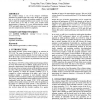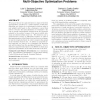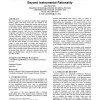GECCO
2008
Springer
14 years 19 days ago
2008
Springer
We are interested in engineering smart machines that enable backtracking of emergent behaviors. Our SSNNS simulator consists of hand-picked tools to explore spiking neural network...
GECCO
2008
Springer
14 years 19 days ago
2008
Springer
We propose a method of knowledge reuse between evolutionary processes that solve different optimization tasks. We define the method in the framework of tree-based genetic progra...
GECCO
2008
Springer
14 years 19 days ago
2008
Springer
XCS with computed prediction, namely XCSF, has been recently extended in several ways. In particular, a novel prediction update algorithm based on recursive least squares and the ...
GECCO
2008
Springer
2008
Springer
Bond-graphs + genetic programming: analysis of an automatically synthesized rotary mechanical system
14 years 19 days ago
Initial results of an experiment devised to combine Bond-Graph modeling and simulation with genetic programming for automated design of a simple mechatronic system are reported in...
GECCO
2008
Springer
14 years 19 days ago
2008
Springer
The evolution strategy is one of the strongest evolutionary algorithms for optimizing real-value vectors. In this paper, we study how to use it for the evolution of prediction wei...
GECCO
2008
Springer
14 years 19 days ago
2008
Springer
We propose the use of rough sets theory to improve the first approximation provided by a multi-objective evolutionary algorithm and retain the nondominated solutions using a new ...
GECCO
2008
Springer
14 years 19 days ago
2008
Springer
This study proposes an agent-based model where adaptively learning agents with local vision who are situated in the Prisoner’s Dilemma game change their strategy and location as...
GECCO
2008
Springer
14 years 19 days ago
2008
Springer
With the growing number of acquired physiological and behavioral biometric samples, biometric data sets are experiencing tremendous growth. As database sizes increase, exhaustive ...
GECCO
2008
Springer
14 years 19 days ago
2008
Springer
For artificial entities to achieve high degrees of autonomy they will need to display appropriate adaptability. In this sense adaptability includes representational flexibility gu...
GECCO
2008
Springer
14 years 19 days ago
2008
Springer
This paper focuses on the study of the behavior of a genetic algorithm based classifier system, the Adapted Pittsburgh Classifier System (A.P.C.S), on maze type environments con...



